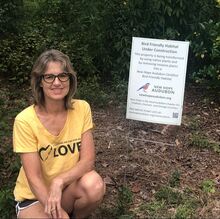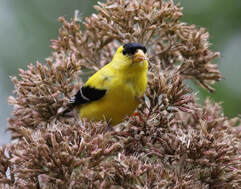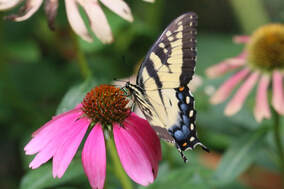THE BIODIVERSITY CRISIS
The loss of biodiversity is an existential crisis intertwined with and on a par with global warming. Seas are overfished, threatening a collapse of the ocean ecosystems; there are 3 billion fewer birds since 1970 just in North America alone (a 30% decline), and they are our “canaries in the coal mine” so to speak; butterflies and other pollinators are on an alarming decline, just part of an insect apocalypse; and so on. David Attenborough in his book, A Life on our Planet: My Witness Statement and Vision of the Future, has witnessed a decline of remaining wilderness from 66 percent in his youth in 1937 to 35 percent in 2020 when he wrote the book.
Of course, we should advocate on a local, state and national level for legislation and actions by government agencies and legislature to stem this loss. But you also can support biodiversity locally, starting in your own yard and community. Many of the ideas in this section come from Doug Tallamy’s recent book, Nature’s Best Hope: A New Approach to Conservation That Starts in Your Your Yard. For more information on his concept of how your yard and community can become part of a homegrown national park and details on many of the items below, see this blog article: Help Build a Homegrown National Park.
Of course, we should advocate on a local, state and national level for legislation and actions by government agencies and legislature to stem this loss. But you also can support biodiversity locally, starting in your own yard and community. Many of the ideas in this section come from Doug Tallamy’s recent book, Nature’s Best Hope: A New Approach to Conservation That Starts in Your Your Yard. For more information on his concept of how your yard and community can become part of a homegrown national park and details on many of the items below, see this blog article: Help Build a Homegrown National Park.
 Bird friendly habitat under construction in Laura's yard where she is adding native plants and removing invasive plants
Bird friendly habitat under construction in Laura's yard where she is adding native plants and removing invasive plants
Using native plants
Why natives? Native plants are those that occur naturally in our area having been here prior to European settlement. Complex ecosystems have evolved with these plants as the foundation. Some recommended native plants for the Piedmont of North Carolina can be found at this website link.
Removing invasive plants
We have imported many of the common plants that you see in neighborhood gardens based largely on their value as ornamental plants. They typically do not offer much value for wildlife, and some readily and aggressively spread outside their original boundaries becoming serious threats to ecosystems. The North Carolina Botanical Garden has written a very helpful booklet , “Controlling Invasive Plants.”
Having a variety of nectar producing plants blooming and host plants available throughout the growing season to support pollinators
Hummingbirds, butterflies, moths, native bees, and other pollinating insects are threatened by loss of habitat and use of pesticides. You can help them by adding native plants that bloom at different times of the year to give them the nectar and pollen they need as food throughout the growing season. Birds will also benefit from seeds and berries through the seasons.
Using native plants
Why natives? Native plants are those that occur naturally in our area having been here prior to European settlement. Complex ecosystems have evolved with these plants as the foundation. Some recommended native plants for the Piedmont of North Carolina can be found at this website link.
Removing invasive plants
We have imported many of the common plants that you see in neighborhood gardens based largely on their value as ornamental plants. They typically do not offer much value for wildlife, and some readily and aggressively spread outside their original boundaries becoming serious threats to ecosystems. The North Carolina Botanical Garden has written a very helpful booklet , “Controlling Invasive Plants.”
Having a variety of nectar producing plants blooming and host plants available throughout the growing season to support pollinators
Hummingbirds, butterflies, moths, native bees, and other pollinating insects are threatened by loss of habitat and use of pesticides. You can help them by adding native plants that bloom at different times of the year to give them the nectar and pollen they need as food throughout the growing season. Birds will also benefit from seeds and berries through the seasons.
 Goldfinch eating seeds of Joe Pye weed, a late summer bloomer
Goldfinch eating seeds of Joe Pye weed, a late summer bloomer
Creating pollinator and beneficial insect nesting habitats
Several nesting habitats must be provided to support the next generation of pollinators and other beneficial insects, and it is a common failure in creating wildlife habitats to neglect this part. It is very important to not have grass under the trees and instead allow the leaves to fall and be as undisturbed as possible out to the edge of the drip line or, even better, over an entire grove of trees.
Leaving snags and nurse logs
A snag is part of a dead or dying tree left standing, and a nurse log is a fallen tree or limb left lying on the ground. A snag can provide nesting habitat for birds, beneficial insects, and, as mentioned, some bees. Woodpeckers and other birds also use them to find insects. A nurse log can provide nesting habitat for pollinators, a place for new plants to germinate, and a place to find insects for birds. CAUTION: Only leave snags where they won’t present safety hazards when they eventually fall.
Preventing bird window collisions
According to the American Bird Conservancy, “Millions of birds die every year flying into windows because they can’t tell reflections from trees, plants and sky.” You can get information on preventing window strikes and how to deal with stunned birds from the Cornell Lab of Ornithology’s article, “Why Birds Hit Windows.” Other tips can be found in this blog article: “Preventing that Dreaded Thump,”
Having a wildlife water feature
Wildlife need a ready source of fresh water to survive, so small ponds, bird baths, water drips, etc. improve your habitat. These water sources need to be kept clean and fresh, especially bird baths. Also locate bird baths out of reach of predators such as cats.
Keeping cats indoors at all times or in outdoor enclosure
Outdoor cats kill millions of birds and other small animals each year and are a special threat to fledglings and ground-nesting birds. See the blog article on “Living with Cats and Birds.”
Having outdoor security lighting on motion sensors or turning them off when not needed – not leaving on all night
Bright lights at night attract adult moths and other night-flying insects. They spend all their energy flying around the lights instead of seeking out nectar for food and mating and are easy targets for nighttime predators. These adult insects provide essential ecosystem functions of pollinating plants, and the moth’s caterpillars provide essential food for baby birds.
Reducing lawn area with non-native turfgrass to minimum needed.
Lawns with the typical nonnative grasses such as fescue can require fertilizers, herbicides, insecticides, and frequent mowing, all of which are detrimental to wildlife and the environment. Grass lawns are a food desert for pollinators, birds, and other wildlife . Creating natural areas with native plants and leaf mulch is a much better and lower maintenance alternative.
Several nesting habitats must be provided to support the next generation of pollinators and other beneficial insects, and it is a common failure in creating wildlife habitats to neglect this part. It is very important to not have grass under the trees and instead allow the leaves to fall and be as undisturbed as possible out to the edge of the drip line or, even better, over an entire grove of trees.
Leaving snags and nurse logs
A snag is part of a dead or dying tree left standing, and a nurse log is a fallen tree or limb left lying on the ground. A snag can provide nesting habitat for birds, beneficial insects, and, as mentioned, some bees. Woodpeckers and other birds also use them to find insects. A nurse log can provide nesting habitat for pollinators, a place for new plants to germinate, and a place to find insects for birds. CAUTION: Only leave snags where they won’t present safety hazards when they eventually fall.
Preventing bird window collisions
According to the American Bird Conservancy, “Millions of birds die every year flying into windows because they can’t tell reflections from trees, plants and sky.” You can get information on preventing window strikes and how to deal with stunned birds from the Cornell Lab of Ornithology’s article, “Why Birds Hit Windows.” Other tips can be found in this blog article: “Preventing that Dreaded Thump,”
Having a wildlife water feature
Wildlife need a ready source of fresh water to survive, so small ponds, bird baths, water drips, etc. improve your habitat. These water sources need to be kept clean and fresh, especially bird baths. Also locate bird baths out of reach of predators such as cats.
Keeping cats indoors at all times or in outdoor enclosure
Outdoor cats kill millions of birds and other small animals each year and are a special threat to fledglings and ground-nesting birds. See the blog article on “Living with Cats and Birds.”
Having outdoor security lighting on motion sensors or turning them off when not needed – not leaving on all night
Bright lights at night attract adult moths and other night-flying insects. They spend all their energy flying around the lights instead of seeking out nectar for food and mating and are easy targets for nighttime predators. These adult insects provide essential ecosystem functions of pollinating plants, and the moth’s caterpillars provide essential food for baby birds.
Reducing lawn area with non-native turfgrass to minimum needed.
Lawns with the typical nonnative grasses such as fescue can require fertilizers, herbicides, insecticides, and frequent mowing, all of which are detrimental to wildlife and the environment. Grass lawns are a food desert for pollinators, birds, and other wildlife . Creating natural areas with native plants and leaf mulch is a much better and lower maintenance alternative.
 Tiger swallowtail getting nectar from purple coneflower will be harmed by pesticide use.
Tiger swallowtail getting nectar from purple coneflower will be harmed by pesticide use.
Using only organic fertilizer
Healthy garden soil with leaf mulch needs little or no fertilizing. But if you have to use fertilizers, use organic ones. In contrast to non-organics, they release nutrients slowly, preventing runoff of chemicals that damage streams and lakes, and they build the soil and nourish micro-organisms that are vital to soil health.
Reducing or eliminating use of insecticides and herbicides and eliminating rodenticides.
Insecticides are indiscriminate in that they kill both their intended target along with beneficial organisms and insects, and they are dangerous to humans and wildlife. Control mosquitoes by eliminating breeding sites rather than indiscriminate spraying, which harms butterflies, moths, bees, and other native insects. Avoid buying plants on which the neonicotinoid and other systemic insecticide have been used since they remain in the plant tissue and pollen and harm pollinators. Limited use of herbicides may be necessary to eliminate the harder to control invasive shrubs using a cut and paint method, but persistent and widespread use is not recommended since it can be harmful to humans and wildlife and collect in runoff to streams. Do not use rodenticides. Rodenticides kill rodents by causing them to bleed to death internally, but that death can be slow and painful. Birds of prey such as hawks and owls will catch poisoned rodents while they are still moving around and then can suffer the same fate of slowly bleeding to death. Again, for more detail on this and many of the items above, read this blog article: Help Build a Homegrown National Park.
Healthy garden soil with leaf mulch needs little or no fertilizing. But if you have to use fertilizers, use organic ones. In contrast to non-organics, they release nutrients slowly, preventing runoff of chemicals that damage streams and lakes, and they build the soil and nourish micro-organisms that are vital to soil health.
Reducing or eliminating use of insecticides and herbicides and eliminating rodenticides.
Insecticides are indiscriminate in that they kill both their intended target along with beneficial organisms and insects, and they are dangerous to humans and wildlife. Control mosquitoes by eliminating breeding sites rather than indiscriminate spraying, which harms butterflies, moths, bees, and other native insects. Avoid buying plants on which the neonicotinoid and other systemic insecticide have been used since they remain in the plant tissue and pollen and harm pollinators. Limited use of herbicides may be necessary to eliminate the harder to control invasive shrubs using a cut and paint method, but persistent and widespread use is not recommended since it can be harmful to humans and wildlife and collect in runoff to streams. Do not use rodenticides. Rodenticides kill rodents by causing them to bleed to death internally, but that death can be slow and painful. Birds of prey such as hawks and owls will catch poisoned rodents while they are still moving around and then can suffer the same fate of slowly bleeding to death. Again, for more detail on this and many of the items above, read this blog article: Help Build a Homegrown National Park.
To contact the Eco Ministry with questions, get on our Friends of the Eco Ministry for the Earth email list, or explore joining our committee send an email to [email protected].
